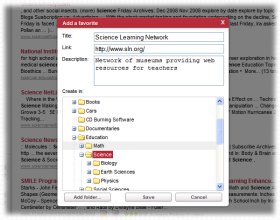|
Education
Web
Viewing 1-5 of 5 total results
Earth Day: Population Simulation with M&M's
display class data (or a subset of class data) to increase the size of your sample and give the entire class one set of data to consider. This can be done with the whole group, or you can have four pairs combine their data and consolidate that for the class....
of change in real-world problems; Sample Task: Use the Census Bureau website to find information regarding population patterns or economic data and display the results graphically. Linkages: Write about patterns in nature or other areas of science, and find and apply form...
1
0
of change in real-world problems; Sample Task: Use the Census Bureau website to find information regarding population patterns or economic data and display the results graphically. Linkages: Write about patterns in nature or other areas of science, and find and apply formulas in business or science. Content Standard 3.0: Geometry Students will investigate, model, and apply geometric properties and relationships. Learning Expectations: The student will: 3.1 apply geometric properties
3
0
http://www.state.tn.us/education/ci/math/doc/MA_3130.pdf#page=3
www.state.tn.us/education/ci/math/doc/MA_3130.pdf#page=3
<span class="highlight">of</span> change in real-world problems; <span class="highlight">Sample</span> Task: Use the Census Bureau website to find information regarding population patterns or economic data and display the results graphically. Linkages: Write about patterns in nature or other <span class="highlight">areas</span> <span class="highlight">of</span> science, and find and apply formulas in business or science. Content Standard 3.0: Geometry Students will investigate, <span class="highlight">model</span>, and apply geometric properties and relationships. Learning Expectations: The student will: 3.1 apply geometric properties
Root Theorem, and Synthetic Division). Sample Task: Examine patterns found in Pascal’s Triangle. Linkages: Mathematics: Statistics and Probability. Data analysis and pattern recognition in science. Standard 3.0: Geometry The student will: Learning Expectations: 3.1 apply and j...
1
0
Root Theorem, and Synthetic Division). Sample Task: Examine patterns found in Pascal’s Triangle. Linkages: Mathematics: Statistics and Probability. Data analysis and pattern recognition in science. Standard 3.0: Geometry The student will: Learning Expectations: 3.1 apply and justify properties of quadrilaterals and circles; 3.2 solve real world problems involving volume of geometric solids;
3
0
http://www.state.tn.us/education/ci/math/doc/MA_3134.pdf#page=3
www.state.tn.us/education/ci/math/doc/MA_3134.pdf#page=3
Root Theorem, and Synthetic Division). <span class="highlight">Sample</span> Task: Examine patterns found in Pascal’s Triangle. Linkages: Mathematics: Statistics and Probability. Data analysis and pattern <span class="highlight">recognition</span> in science. Standard 3.0: Geometry The student will: Learning Expectations: 3.1 apply and justify properties <span class="highlight">of</span> quadrilaterals and circles; 3.2 solve real world problems involving volume <span class="highlight">of</span> geometric solids;
expectations, all students in Grade 11 will be able to: Building upon the K-11 expectations, all student in Grade 12 will be able to: Collect: • Describe and explain how the validity of predictions are affected by number of trials, sample size, and the population Represent:...
1
0
expectations, all students in Grade 11 will be able to: Building upon the K-11 expectations, all student in Grade 12 will be able to: Collect: • Describe and explain how the validity of predictions are affected by number of trials, sample size, and the population Represent: • Select and interpret the most appropriate display for a given purpose and set(s) of data (e.g., histograms, parallel box plots, stem-and-leaf plots, scatter plots) • Find an appropriate mathematical model of a linear or
9
0
http://www.doe.k12.de.us/infosuites/staff/ci/content_areas/files/Math%20GLE%209-12%208-08.pdf#page=9
www.doe.k12.de.us/infosuites/staff/ci/content_areas/files/Math%20GLE%209-...
expectations, all students in Grade 11 will be able to: Building upon the K-11 expectations, all student in Grade 12 will be able to: Collect: • Describe and explain how the validity <span class="highlight">of</span> predictions are affected by number <span class="highlight">of</span> trials, <span class="highlight">sample</span> size, and the population Represent: • Select and interpret the most appropriate display for a given purpose and set(s) <span class="highlight">of</span> data (e.g., histograms, parallel box plots, stem-and-leaf plots, scatter plots) • Find an appropriate mathematical <span class="highlight">model</span> <span class="highlight">of</span> a linear or
pie chart. #0;9 3108.5.2 Translate from one representation of data to another (e.g., bar graph to pie graph, pie graph to bar graph, table to pie graph, pie graph to chart) accurately using the area of a sector. #0;9 3108.5.3 Estimate or calculate simple geometric probabi...
1
0
pie chart. #0;9 3108.5.2 Translate from one representation of data to another (e.g., bar graph to pie graph, pie graph to bar graph, table to pie graph, pie graph to chart) accurately using the area of a sector. #0;9 3108.5.3 Estimate or calculate simple geometric probabilities (e.g., number line, area model, using length, circles). State Performance Indicators: SPI 3108.5.1 Use area to solve problems involving geometric probability (e.g. dartboard problem, shaded sector of a circle, shaded region
6
0
http://www.state.tn.us/education/ci/math/doc/MA_3108.pdf#page=6
www.state.tn.us/education/ci/math/doc/MA_3108.pdf#page=6
pie chart. #0;9 3108.5.2 Translate from <span class="highlight">one</span> representation <span class="highlight">of</span> data to another (e.g., bar graph to pie graph, pie graph to bar graph, table to pie graph, pie graph to chart) accurately <span class="highlight">using</span> the area <span class="highlight">of</span> a sector. #0;9 3108.5.3 Estimate or calculate simple geometric probabilities (e.g., number line, area <span class="highlight">model</span>, <span class="highlight">using</span> length, circles). State Performance Indicators: SPI 3108.5.1 Use area to solve problems involving geometric probability (e.g. dartboard problem, shaded sector <span class="highlight">of</span> a circle, shaded region
|
